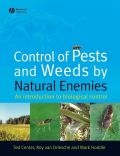
Written by leading international experts in the field, this text offers an integrated look at biological control of invasive species and the role of natural enemies in pest management. INDICE: Preface.Part I: Scope of biological control:.1. Introduction.2. Types of biological control, targets, and agents.What is biological control?.Permanent control over large areas.Temporary pest suppression in production areas.Kinds of targets and kinds of agents.Part II: Kinds of natural enemies:.3. Parasitoid diversity and ecology.What is a parasitoid?.Terms and processes.Some references to parasitoid families.Groups of parasitoids.Finding hosts.Host recognition and assessment.Defeating host defenses.Regulating host physiology.Patch-time allocation.4. Predator diversity and ecology.Non-insect predators.Major groups of predatory insects.Overview of predator biology.Predator foraging behavior.Predators and pest control.Effects of alternative foods on predator impact.Interference of generalist predators with classical biological control agents.Predator and prey defense strategies.5. Weed biocontrol agent diversity and ecology.The goal of weed biological control.Terms and processes.Herbivory and host finding.Herbivore guilds.Groups of herbivores and plant pathogens.6. Arthropod pathogen diversity and ecology.Bacterial pathogens of arthropods.Viral pathogens of arthropods.Fungal pathogens of arthropods.Nematodes attacking arthropods.Generalized arthropod pathogen life cycle.Epidemiology: what leads to disease outbreaks?.Part III: Invasions: why biological control is needed:.7.The invasion crisis.Urgency of the invasion crisis.Case histories of four high-impact invaders.The extent of harmful impact by invaders.How do invasive species get to new places?.Why do some invasions succeed but others fail?.Invaderecology and impact.8. Ways to suppress invasive species.Prevention: heading off new invasions through sound policy.Eradication based on early detection.Invaders that do no harm.Control of invasive pests in natural areas.Factors affecting control in natural areas.Control of invasive species in crops.Part IV: Natural enemy introductions: theory and practice:.9. Interaction webs as the conceptual framework for classical biological control.Terminology.Forces setting plant population density.Forces setting insect population density.Predictions about pests based on food webs.10. The role of population ecology and population models in biological control: Joseph Elkinton (University of Massachusetts).Basic concepts.Population models.11. Classical biological control.Introduction.Classical biological control.New-association biological control.Summary.12. Weed biological control.Differences and similarities between weed and arthropod programs.Why plants become invasive.Selecting suitable targets for weed biological control.Conflicts of interest in weed biological control.Faunal inventories: finding potential weed biological control agents.Safety: will those bugseat my roses?.Pre-release determination of efficacy.How many agents are necessary for weed control?.Release, establishment, and dispersal.Evaluation of impacts.Non-target impacts.When is a project successful?.Conclusions.Part V: Tools for classical biological control:.13. Foreign exploration.Planning and conducting foreign exploration.Shipping natural enemies.Operating a quarantine laboratory.Managing insect colonies in quarantine.Developing petitions for releaseinto the environment.14. Climate matching.Climate matching.Inductive modeling: predicting spread and incursion success.Deductive modeling: predicting spread and incursion success.Conclusions.15. Molecular tools: Richard Stouthamer (University of California Riverside).Types of molecular data.Important biological control issues that molecular techniques can address.Conclusions.Part VI: Safety:.16. Non-target impacts of biological control agents.Biological control as an evolving technology.The amateur to early scientific period (18001920).A developing science makes some mistakes (192070).Broadening perspectives (197090).Current practice and concerns. Re-greening biological control.17. Predictingnatural enemy host ranges.Literature records.Surveys in the native range.Laboratory testing to estimate host ranges.Interpretation of tests.Examples of host-range estimation.Risk assessment.18. Avoiding indirect non-target impacts.Kinds of potential indirect effects.Can risk of indirect impacts be reduced by predicting natural enemy efficacy?.Part VII: Measuring natural enemy impacts onpests:.19. Field colonization of natural enemies.. Part VIII: Conserving biological control agents in crops:.21. Protecting natural enemies from pesticides.Problems with pesticides.Super pests and missing natural enemies.Dead wildlife and pesticide residues in food.Cases when pesticides are the best tool.How pesticides affect natural enemies.Seeking solutions: physiological selectivity.Pesticide-resistant natural enemies.Ecological selectivity: using non-selective pesticides with skill.Transgenic Bt crops: the ulimate ecologically selective pesticide..Part IX: Biopesticides:.23. Microbial pesticides: issues and concepts.History of microbial insecticides.What makes a pathogen a likely biopesticide?.Overview of options for rearing pathogens.Agent quality: finding it, keeping it, improving it.Measuring the efficacy of microbial pesticides.Degree ofmarket penetration and future outlook. Part X: Augmentative biological control:.25. Biological control in greenhouses.Historical beginnings.When are greenhouses favorable for biological control?.Natural enemies available from the insectary industry.Growers commitment to change.Requirements for success: efficacy and low cost.Methods for mass rearing parasitoids and predators.Practical use of natural enemies.Programs with different biological control strategies.Integration of multiple biocontrol agents for several pests.Safety of natural enemy releases in greenhouses..Part XI: Other targets and new directions:.27. Vertebrate pests.Predators as vertebrate control agents.Parasites as vertebrate control agents.Pathogens as vertebrate control agents.New avenues for biological control of vertebrates.Conclusions.29. Future directions.Classical biological control.Conservation biological control.Augmentation biological control.Biopesticides.Conclusions.References.Index
- ISBN: 978-1-4051-4571-8
- Editorial: Blackwell
- Encuadernacion: Rústica
- Páginas: 484
- Fecha Publicación: 21/04/2008
- Nº Volúmenes: 1
- Idioma: Inglés
